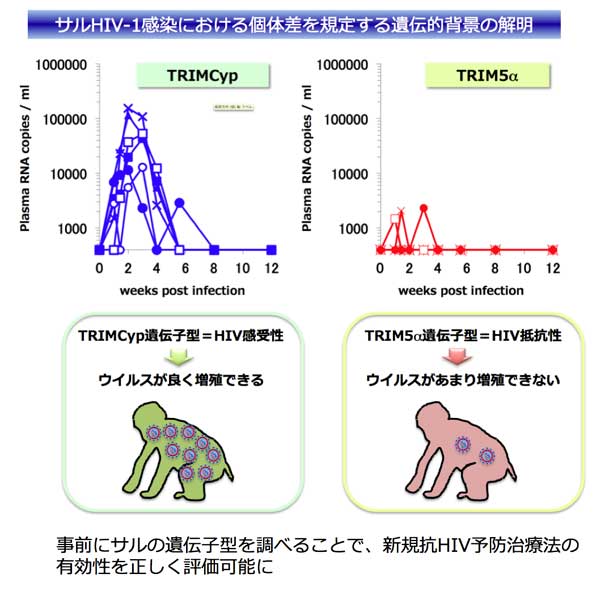TRIM5 genotypes in cynomolgus monkeys primarily influence inter-individual diversity in susceptibility to monkey-tropic human immunodeficiency virus type 1Akatsuki Saito, Masako Nomaguchi, Ken Kono, Yasumasa Iwatani, Masaru Yokoyama, Yasuhiro Yasutomi, Hironori Sato, Tatsuo Shioda, Wataru Sugiura, Tetsuro Matano, Akio Adachi, Emi E. Nakayama, and Hirofumi Akari エイズの原因ウイルスであるヒト免疫不全ウイルス1型(HIV-1)は実験用サル類で感染発症しないことが知られています。そのため、エイズ病態や感染免疫応答などの研究でサルエイズウイルスであるSIVおよびSIVとHIV-1のキメラであるSHIVを用いた霊長類モデルが広く用いられてきました。他方、SIV, SHIVモデルでは研究が難しいHIV-1特異的な予防治療ワクチンや新規薬剤の評価研究推進のためには、HIV-1そのものが感染する霊長類モデルの開発が求められます。我々は、近年開発に成功したサル指向性HIV-1(HIV-1mt)を応用した次世代評価システムとしての新規霊長類モデル開発を推進しています。この一連の研究過程で、カニクイザルにはHIV-1mtが効率よく感染する「感受性」個体と、ほとんど感染しない「抵抗性」個体が存在することに気付きました。このウイルス許容性の違いに何らかの遺伝的背景が関与しているのではないかと考え、近年注目されているレトロウイルス抵抗性因子であるTRIM5遺伝子に着目して検討を行いました。その結果、TRIM5遺伝子の変異アリルであるTRIMCyp遺伝子型を持つカニクイザルでは、野生型アリルであるTRIM5α遺伝子型を持つサルと比較して、HIV-1mtを実験感染した際のウイルス増殖性が顕著に高いことを明らかにしました。この結果は、TRIM5遺伝子多型がカニクイザルのHIV-1mt許容性を規定する主要な宿主因子であることを示すものであり、TRIM5の抗ウイルス機能解明に繋がる重要な知見と考えられます。また近い将来、HIV-1mt感染モデルによる新規予防治療法の評価研究を行う際には、カニクイザルのTRIM5遺伝子情報に基づきHIV-1mt「抵抗性」個体をあらかじめ除外することが可能となります。このことは、当霊長類モデルを用いた新規予防治療法の評価研究において、高い信頼性・再現性のある実験結果に繋がることが期待されます。なお本研究成果は2013年3月13日にJournal of General Virology誌オンライン版に掲載されました。 website:
http://vir.sgmjournals.org/content/early/2013/03/07/vir.0.050252-0.abstract 
Human immunodeficiency virus type 1 (HIV-1) productively infects only humans but not Old World monkeys such as cynomolgus macaques (CMs), whereas simian immunodeficiency virus (SIV) can efficiently replicate in the latter. This species barrier makes it difficult to develop suitable animal models for HIV-1 infection. In this point of view, a monkey-tropic HIV-1 (HIV-1mt) will be a promising model because HIV-1mt productively infects macaque monkeys.
In this study, we show for the first time that a polymorphism in the CM TRIM5 gene, which encodes one of the intrinsic anti-retroviral cellular factors, primarily influences inter-individual diversity in terms of susceptibility to HIV-1mt. Especially, it is notable that the CMs having TRIMCyp, a variant allele of TRIM5, exhibit greater susceptibility to HIV-1mt infection as compared with the monkeys homozygous for TRIM5a, a wild-type allele. On the basis of our findings, it has become possible to identify the individual susceptibility by pre-screening of TRIM5 genotypes, which is invaluable for establishing a pre-clinical CM model of HIV-1mt infection. Our findings will also provide an important insight into the divergent susceptibility of macaque monkeys to HIV-1. MAR/18/2013
Copyright(C) 2012 PRI ( ). ).
|







